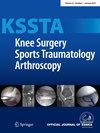Evaluation of a novel robotic testing method for stability and kinematics of total knee arthroplasty
Abstract
Purpose
This work developed a novel preclinical test of total knee replacements (TKRs) in order to explain TKR instability linked to patient dissatisfaction. It was hypothesized that stability tests on the isolated moving prostheses would provide novel comparative data on the stability and kinematics among TKR designs.
Methods
Three TKR designs, DePuy Synthes Attune MS, Stryker Triathlon and Zimmer Biomet Persona MC, were assessed using a robotic arm while flexing–extending 0–140°. Tests imposed 710 N body weight combined with three tibial loads: no anterior–posterior (AP) force, 90 N anterior or 90 N posterior force. Other load effects were minimized and the kinematics was recorded. Each implant was tested six times to investigate the repeatability of the method. Data were analysed using statistical parametric mapping with one-way analysis of variance (ANOVA). If significance was found (p < 0.05), post hoc t tests with Bonferroni correction were used to contrast groups.
Results
Significant differences were found throughout flexion–extension. Femoral rollback, AP stability, coupled internal–external rotation and AP position (roll-back) were all influenced by implant design. AP stability of the TKRs reduced with flexion reaching Attune 15 mm, Persona 13 mm and Triathlon 21 mm at 140° flexion. Tractive rolling significantly affected kinematics in the less congruent Triathlon design, with 6 mm different paths between flexion and extension motion (p < 0.05 across 5–100°). Paradoxical anterior femoral sliding in early flexion (0–40°) occurred in Persona and Triathlon designs.
Conclusions
The novel testing technique provides, for the first time, comparative data on the inherent stability and kinematics of the TKR implants themselves across the arc of flexion–extension, independent of variables including soft tissue behaviour and surgical technique. The data show how much each prosthesis can contribute to the stability and motion of the implanted knee. Similar data from a wider range of designs will enable more informed decisions regarding implant design choice, aiming to reduce the prevalence of TKR instability in patients.
Level of Evidence
Controlled laboratory study.





 求助内容:
求助内容: 应助结果提醒方式:
应助结果提醒方式:


